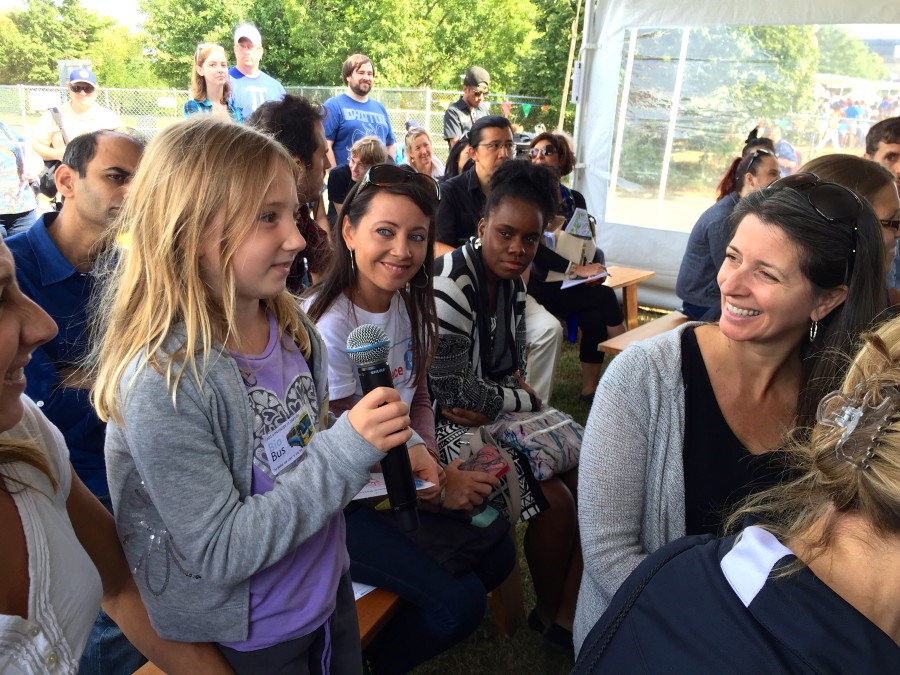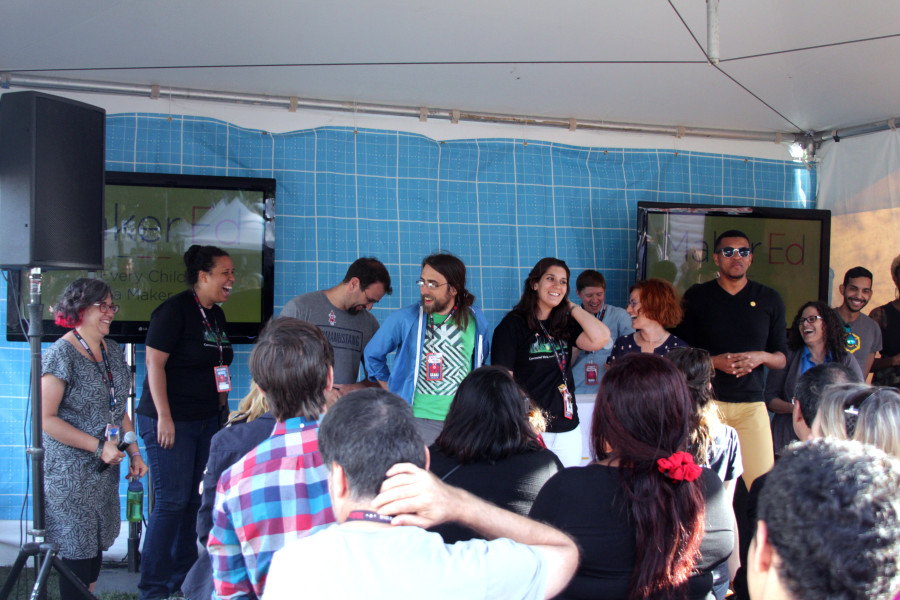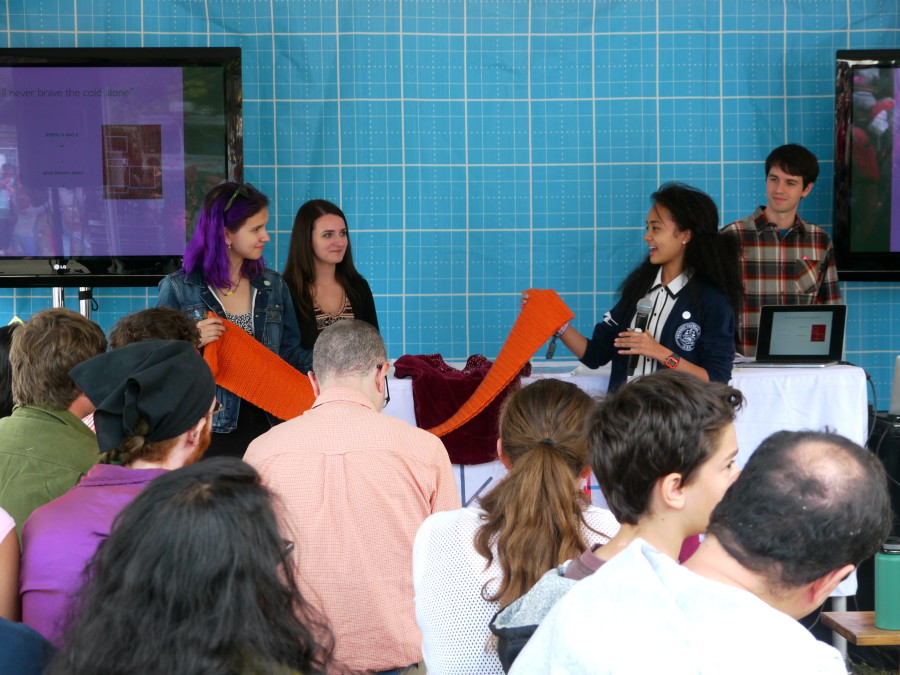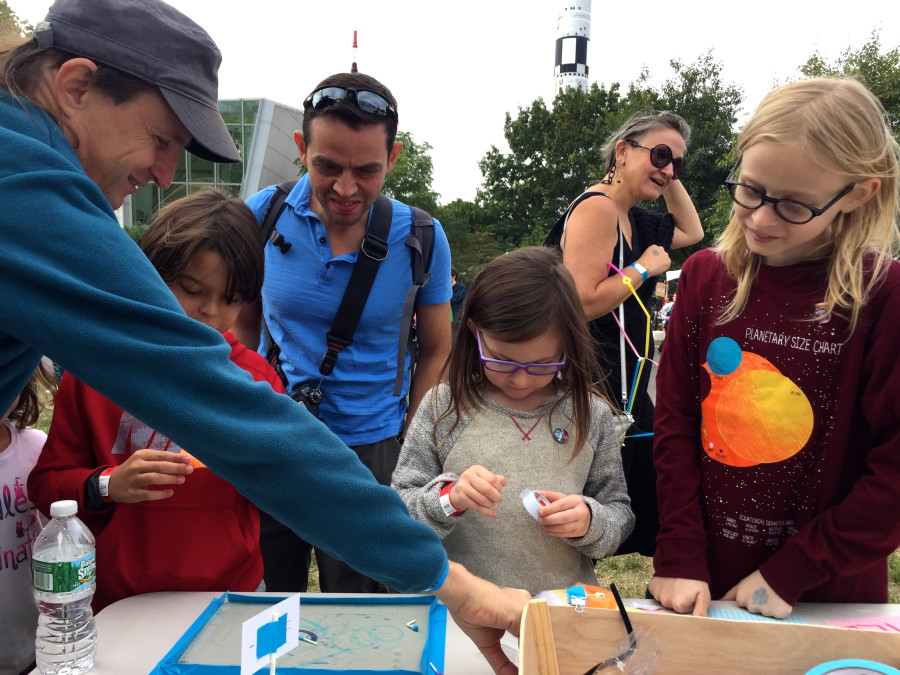On September 26-27, members of our team spent two sunny days at the New York Hall of Science in Queens, NY for World Maker Faire, an event organized by Maker Media that brings together makers and creators of all ages to share their ideas and their work.
Our role at the Faire? (That is, besides enjoying all the awe-inspiring exhibits and connecting with vibrant creative folks from around the world?) For the 7th time between Bay Area and NYC World Maker Faires, Maker Ed curated and ran the Education Stage.
Speakers and audience members gathered under the shady tent of our Education Stage for 29 talks — 14 of which were delivered by youth between the ages of 5 and 18. The talks ranged in topic, but all related to making and its role in education and youth development. (For a detailed description of each of the talks, check out the Maker Faire program). Overall, a huge range of educational institutions and roles were represented, including educators, administrators, and researchers in libraries, museums, schools of every type, universities, community and non-profit organizations, and more.
The talks themselves were both captivating and uplifting (as usual). Speakers shared stories, tips, and ideas centered around giving young people the opportunity to bring passion and creativity to learning through making. Student presenters showcased projects made in and out of school, shared learning philosophies, and contributed to panels on making in higher education and the use of Arduinos in education.
Of the talks I saw personally, I especially enjoyed a Maker Ed-organized panel in which educators shared 2-minute stories. In the two sessions of this panel that we held throughout the weekend, we heard from…
- a teacher at Monticello High School in Albemarle County, who shared his own high school experience of hating school and wanting to spend his time creating music instead. He said that, as an educator, he’s now able to provide that opportunity to his students with the digital music lab in Monticello’s library. His words of advice to educators: if a student has an idea, and wants to make something, find a way to make it happen because, even if it’s not related to what they’re supposed to be learning, it will make them more passionate about learning as a whole.
- Andy Forest, the co-founder of STEAMLabs, who shared a story of a young person who came to camp unexcited about learning, behind in all academic subjects, literacy in particular. At the camp, this young person was into it, passionately creating and making things to their heart’s content. After the camp, Andy received a note from parents saying that, since the camp, that young person has become more interested in school, and now wants to learn to read!
- David Wells, the Manager of Creative Making & Learning at New York Hall of Science, who shared a story of a young maker rejecting his suggestion to use a different material when creating an instrument, as a way to illustrate how making can help young people have the confidence to stand up for their own ideas.
- and other, equally inspiring stories about educators encouraging their students to develop maker identities, becoming more comfortable with taking risks, and so much more.
Another one of my personal favorites of the talks I attended was a presentation given by three amazing high school students representing Friends’ Central School Makerspace in Pennsylvania. They shared three unique projects that they had created, all of which focused on taking something abstract or intangible and turning it into something permanent, personal, and shareable. One student embedded a message into a crocheted scarf through morse code. (The message, from a mentor, was “You’ll never brave the cold alone.” Heartwarming, right?) Another created 3D printed models of her voice saying “I love you” (and other caring phrases) to give as gifts to her friends. And the third student translated DNA sequences — both dolphin and human — into beautiful music (that may or may not have brought tears to my eyes). Check out the blog post they shared about their presentation here.
Just from these few examples, you can see the quality of the talks we had at our stage, and that there is an incredible momentum around maker education. In fact, our Director of Education, Steve Davee, who has been part of the Maker Ed team since its early days, mentioned that he noticed a shift from the early years of running the Education Stage. Overall, it seemed that speakers focused less on why and more on how to enhance learning and life experiences through all forms of creative expression — which just goes to show how much this movement has gained traction in recent years.
 In fact, there was a ton of interest in education among the Faire’s attendees. Our stage was packed, even overflowing at times. For each our first five talks on Saturday morning, we had well over 50 people soaking up the stories and ideas shared by presenters. And on Sunday, one educator came up and told me that she had initially come to see one talk in the morning, and ended up staying for four. (And she only left because she needed to stretch her legs and take a lunch break!)
In fact, there was a ton of interest in education among the Faire’s attendees. Our stage was packed, even overflowing at times. For each our first five talks on Saturday morning, we had well over 50 people soaking up the stories and ideas shared by presenters. And on Sunday, one educator came up and told me that she had initially come to see one talk in the morning, and ended up staying for four. (And she only left because she needed to stretch her legs and take a lunch break!)
Outside of our stage, we had a table where our staff and volunteers offered more information about our organization and its work. We had some incredible interactions at that table, and it was clear that there is a huge hunger for maker education in the New York and New Jersey areas. This community not only asked us some fantastic questions, but they also offered themselves as resources for others — a beautiful thing for our team to witness. On Sunday, in keeping with the maker spirit, we set up a second table filled with office supplies, paper, a few LEDs, motors, and batteries, and invited attendees to play and create with these materials.
Overall, even though World Maker Faire felt very different than Maker Faire Bay Area, I left the Faire feeling the same way: inspired and excited about the potential for hands-on creative expression to positively impact the way our children learn and grow. We’re so grateful that we had the opportunity to once again organize the Education Stage, and ecstatic that we were able to help meet an obvious demand for meaningful conversations around maker education.





